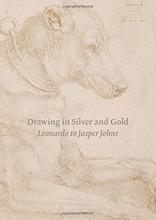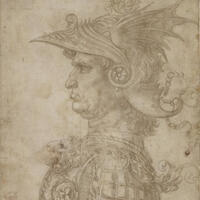More about Head of a Horse from the Parthenon
- All
- Info
- Shop

Sr. Editor
Don’t call it a comeback! Inspired by the past, Alphonse Legros makes metalpoint cool again.
Though you wouldn’t want to pull back the covers on your bed and find this horrifying horse head à la The Godfather, it’s actually an excellent example of the 19th century British revival of metalpoint drawing, of which Legros was an integral part.
Metalpoint drawing, a technique that involves scratching the surface of a paper coated with a kind of rough paste, had fallen out of favor since the height of its popularity during the Italian Renaissance. In Victorian England, though, artists had a renewed interest in Quattrocento (15th century Italian) art and “rediscovered” metalpoint drawing as a viable artistic method. This enthusiasm for the art of the Italian Renaissance was spurred in part by the increasing accessibility of these works to a British audience. For instance, the British Museum collected many Renaissance works throughout this century, mounting their first exhibition of drawings by the Old Masters in 1858. The rise of photography also meant that pictures of Renaissance etchings were more readily available (Edward Burne-Jones had many in his personal collection), and new translations of 14th century texts provided instructional material on metalpoint.
Legros admired the etching styles of Leonardo da Vinci and Andrea del Verrochio, which is evident in the crosshatching in this work (the overlapping diagonal lines used to create shadow). The subject matter, our terrifying ghost horse, also echoes the Renaissance-era interest in antiquity. It’s a drawing of an object in the British Museum, a statue of the head of a horse taken from a frieze on the Parthenon in Athens, Greece. This particular creature led the chariot of Selene, the moon goddess, as she travels down below the horizon, marking the end of the day.
Legros wasn’t completely stuck in the past, though. For one, he preferred the smooth surface of commercially produced paper that had been coated by machine, rather than by hand. The slick surface allowed his stylus to glide across the page, leaving only a very light and delicate mark that gives his drawings an elegant, ethereal appearance (and makes his horse head look like a spooky apparition). He is also credited with being the first artist since Renaissance-times to utilize gold instead of silver to draw his lines. While this didn’t seem to affect the quality of the drawings themselves, he stated that when using gold, as he did for this work, the drawings were less likely to oxidize.
This print was donated to the National Gallery of Art in 1943 by Lessing Rosenwald, heir to part of the Sears, Roebuck Co. fortune thanks to his father who bought 25 percent of the company in 1895, right before the mail-order business really took off. Rosenwald was an avid collector of prints and rare books, and knew early on that he would donate his collection to United States’ institutions, so that they may rival their European counterparts. The prints and drawings all went to the NGA, and the books to the Library of Congress.
Sources
- “Head of a Horse from the Parthenon, 1898.” National Gallery of Art. https://www.nga.gov/collection/art-object-page.8409.html
- Pezzini, Barbara. "(Inter)national Art: The London Old Masters Market and Modern British Painting (1900–14)." In Art Crossing Borders: The Internationalisation of the Art Market in the Age of Nation States, 1750-1914, edited by Baetens Jan Dirk and Lyna
- Sell, Stacey. ""The Interesting and Difficult Medium": The Silverpoint Revival in Nineteenth–century Britain." Master Drawings 51, no. 1 (2013): 63-86. Accessed May 24, 2021. http://www.jstor.org/stable/43705937.
- "Series: The Parthenon Sculptures." The British Museum. https://www.britishmuseum.org/collection/object/G_1816-0610-98
- Smith, J.Y. "Lessing Rosenwald Dies, Donated Art, Rare Books" Washington Post, June 26, 1979 https://www.washingtonpost.com/archive/local/1979/06/26/lessing-rosenwa… Accessed 5/24/2021













